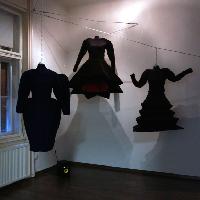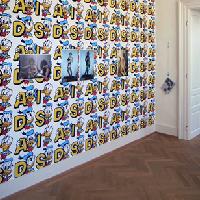In 1988, Berlin became the cultural capital of Europe. For the occasion, the German fashion designer Claudia Skoda was asked to create a fashion show by inviting artist from different corners of Europe. Skoda invited Király, who was the only representative of the Eastern Bloc. His collection was strongly inspired by Oskar Schlemmer’s costumes at the Triadic ballet in that he created his dresses using only circles, triangles, and squares from the perspective of design and only red and black colours separately from the perspective of colour.
In the end, he created 40 dresses, of which three have survived as part of his bequest.
-
Adresa:
-
Creator:
-
Anul creării:
-
Piesă remarcabilă la:
The red star dress was originally displayed in the short movie by the architect Gábor Bachmann: Eastern European Alarm (“Kelet-európai riadó”). The movie is an abstract critique of the late Kádár regime, focusing on social and aesthetical tensions. A woman in the red star plays an important role. Her outlook and attitude serve as a counterpoint to other characters in the middle of the breakdown.
Like many of Király’s works, the red star dress has also been destroyed. Still, the photograph of the dress has been archived.
-
Adresa:
-
Creator:
-
Anul creării:
-
Piesă remarcabilă la:
Karol Radziszewski’s Kisieland is a long-term project that started in 2009. It is a piece documenting encounters of Karol Radziszewski with Ryszard Kisiel. The film is based on Kisiel's private archives and describes the underground queer and avant-garde culture in socialist Poland. It uses different visual representations of queer culture of Polish 1980s. Ryszard Kisiel, a stakeholder of the Queer Archives Institute, took various photographs of queer milieu in dark times of anti-gay campaign "Hiacynth" (1985-86), now Radziszewski stages them as a mean to reconstruct the social history of minority movements, LGBTQ strategies, and artistic avant-garde in martial state Poland.
The masterpiece is one of the founding stones of Polish queer art - it not only shows the roots and genealogies of Polish LGBTQ identity, but also links past experiences with contemporary queer studies' discussion about resistance of minority groups.
Kisieland was purchased by the Museum of Modern Art in Warsaw in 2016 to be included in its permanent collection.
-
Adresa:
-
Warszawa Pańska 3, Poland
-
Limbi:
-
Creator:
-
Anul creării:
-
Piesă remarcabilă la:
Szőnyei found this poster while wandering in Budapest in 1983. He was immediately captured by the originality of the work displaying members of the band Kontroll Csoport as if they were wanted by the police. Below their photos, a few “distinct characteristics” are listed. This was obviously a sarcastic, provocative message for the political power. At the time Szőnyei was not aware that this part of the poster was originally covered by another orange layer stating "Strictly Confidential!" that further added to the play on meaning.
-
Adresa:
-
Limbi:
-
Creator:
-
Anul creării:
-
Piesă remarcabilă la:
Klaniczay Júlia (ed..): A Muhina projekt. Létértelmezések Galántai György életművében / The Mukhina Project. Interpretations of Being in György Galántai's oeuvre, Vintage Galéria, Budapest, 2018, 146 p.
This book, which includes numerous photographs, places the performance “Homage to Vera Mukhina” in a theoretical, historical, and cultural context. Along with the photos, there are diary entries, reproductions of Galántai’s related artworks, and text excerpts and documents originating from Cavellini. There is an interview with Galántai which leads the reader through the book (editor: Júlia Klaniczay). The book offers insights into the creation and execution of the Mukhina performance and also a wider and more detailed picture of connections within the oeuvre. Galántai has always reflected on the world around him and the most important questions in concrete artworks, thus giving interpretations of being.
-
Adresa:
-
1061 Budapest Liszt Ferenc tér 10 , Magyarország
-
Limbi:
-
Creator:
-
Anul creării:
-
Piesă remarcabilă la:





